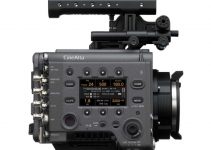As expected, the long-awaited announcement of the Panasonic GH5 has made a huge splash in the industry and for a reason. With its brand new 20.3 MP Micro 4/3 sensor, 4K internal recording at 10bit 4:2:2 up to 30fps, 4K/60p recording at 8bit 4:2:0, 6K photo capture for approximately 18-megapixel stills images and a 5-axis Dual I.S. 2 in-body image stabilization, the camera is reasonably billed as one of the best compact mirrorless cameras of 2017.
But, how does it perform in comparison to its predecessor the GH4? In the following video, US-based documentary filmmaker Griffin Hammond puts to the test 4K 60p recording, in-body image stabilization, crop factor and rolling shutter of the newest Lumix camera.
When it comes to form-factor, the brand new GH5 camera body is a bit thinner as well as a bit taller in comparison to the GH4. It’s also 5.82 ounces (165 grams) heavier than the predecessor. The body of the GH5 doesn’t have a built-in flash on top, but it’s freeze-proof to -10 degrees C and comes equipped with full-size HDMI port, USB-C interface, and dual SD card slots. Now users can utilize two SD cards to organize the captured media better or simply create a backup of their footage while shooting.
The biggest game-changer for Griffin, however, is the built-in 5-Axis Photo/Video Dual Image Stabilization that in essence reduces the jittery motions significantly when shooting hand-held, especially when combined with the Lumix lenses that initially come with optical image stabilization. On those occasions, both systems can communicate and work together thus producing even better results.
Another significant difference between the GH4 and GH5 is the way the last captures 4K video. Unlike its counterpart, the GH5 now has the processing power to utilize the full width of the sensor, thus capturing video without any cropping whatsoever. This workflow produces a wider field of view that can be easily spotted in the two screenshots below.
The brand new sensor of the GH5 also reduces the rolling shutter of the camera which is now as low as 15ms when compared to the 22ms of the GH4.
Considering the built-in Waveform and Vector Scope, upcoming 6K Anamorphic video mode, 1080p Slow-motion at 180fps, full-size HDMI port that output 10-bit 4:2:2 clean video signal at up to 60fps along with the other newly added features and enhancements, you get the ultimate compact mirrorless camera that indie filmmakers could only dream of a few years back.
And, when you add the retail price of $1,998 to the mix, it becomes even harder to get your head around it, but the Panasonic GH5 is certainly here to stay, available for pre-order and ready to ship in March 2017.
[source: Griffin Hammond]
B&H Pre-Order Link:
Lumix DC-GH5 Mirrorless Micro Four Thirds Digital Camera (Body Only)
V-Log L Function Activation Code for DMC-GH4 & DC-GH5
Disclaimer: As an Amazon Associate partner and participant in B&H and Adorama Affiliate programmes, we earn a small comission from each purchase made through the affiliate links listed above at no additional cost to you.




But does it djent?
It depends. It’s just a matter of semantics.
🙂 I see what you did right there, mate 🙂 big Jared Dines / Rob Scallon fan right here. Now all we need is a Shovel GH5 🙂
Its being said that Panasonic is buying the Sony IMX269 image sensor for the GH5. Can anybody confirm that? Just curious.
The Sony IMX269 has a much slower readout speed that can not accommodate 4K at 60p.
The Gh5 will probably use a similar sensor to the new Em1 mk2 (which is better and faster then the Sony IMX269 found in Pen f and GX8).
5D Mark II 21 megapixels. GH5 20.3. Does that means that GH5 stills are close, in resolution to those produced by 5D Mark II?
I’m sure this can’t be true: “It’s also 19.86 ounces (563 grams) heavier than the predecessor. ”
I suspect what the author meant was that at 563 grams, it IS heavier than the predecessor.
Actually, the GH5 is 5.82 ounces (165 grams) heavier than the GH4. It’s already fixed. Thanks!